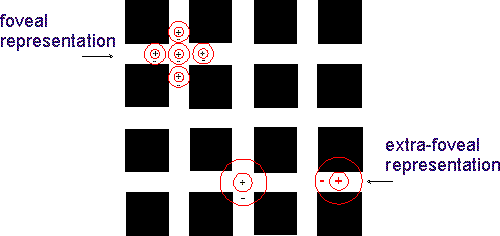 To understand the receptive field explanation for the Hermann grid illusion requires a basic understanding of receptive fields.
To understand the receptive field explanation for the Hermann grid illusion requires a basic understanding of receptive fields.
Once again, it is a matter of lateral inhibition between the center and surround of the receptive field. Note the lower right part of the diagram. The receptive field that lies at the intersection of the white cross has more light falling on its inhibitory surround than does the receptive field that lies between the two black squares. Consequently, the excitatory center of this receptive field between the squares yields a stronger response than that which lies at the intersection of the white cross. This explanation is appropriate for those circumstances where the receptive fields are larger than the spaces between the squares.
Receptive fields in the central fovea are much smaller than in the rest of the retina. This is represented in the upper right of the diagram. In the Hermann grid you probably did not see a dark area when you looked directly at the intersection of the white cross, but did see dark areas in your peripheral vision. To prove to yourself that this is not some trick, just get up and walk away from your computer screen. When you are at some distance from it, you will undoubtedly notice that the dark blob is visible even at your fixation point. I leave it to you to figure out why this happens.
Table of Contents
Subject Index
Table of Contents [When not using frames]